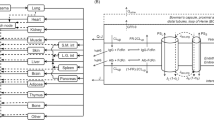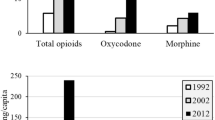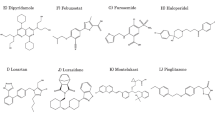Abstract
In the pharmaceutical industry, salt is commonly used to improve the oral bioavailability of poorly soluble compounds. Currently, there is a limited understanding on the solubility requirement for salts that will translate to improvement in oral exposure. Despite the obvious need, there is very little research reported in this area mainly due to the complexity of such a system. To our knowledge, no report has been published to guide this important process and salt solubility requirement still remains unanswered. Physiologically based pharmacokinetic (PBPK) modeling offers a means to dynamically integrate the complex interplay of the processes determining oral absorption. A sensitivity analysis was performed using a PBPK model describing phenytoin to determine a solubility requirement for phenytoin salts needed to achieve optimal oral bioavailability for a given dose. Based on the analysis, it is predicted that phenytoin salts with solubility greater than 0.3 mg/mL would show no further increases in oral bioavailability. A salt screen was performed using a variety of phenytoin salts. The piperazine and sodium salts showed the lowest and highest aqueous solubility and were tested in vivo. Consistent with our analysis, we observed no significant differences in oral bioavailability for these two salts despite an approximate 60 fold difference in solubility. Our study illustrates that higher solubility salts sometimes provide no additional improvements in oral bioavailability and PBPK modeling can be utilized as an important tool to provide guidance to the salt selection and define a salt solubility requirement.







Similar content being viewed by others
REFERENCES
Lipinski CA. Poor aqueous solubility—an industry wide problem in drug discovery. Am Pharm. 2002;5:82–5.
Chiang PC, Chou KJ, Cui Y, Sambrone A, Chan C, Hart R. Evaluation of spray dried drug load and polymer by using a 96-well plate vacuum dry system for amorphous solid dispersion drug delivery. AAPS Pharm Sci Tech. 2012;13:713–22.
Friesen DT, Shanker R, Crew M, Smithey DT, Curatolo WJ, Nightingale JAS. Hydroxypropyl methylcellulose acetate succinate-based spray-dried dispersions: an overview. Mole Pharm. 2008;5:1003–19.
Chiang PC, Thompson DC, Ghosh S, Heitmeier MR. A formulation-enabled pre-clinical efficacy assessment of a farnesoid X receptor (FXR) agonist, GW4064, in hamsters and cynomolgous monkeys. J Pharm Sci. 2011;100:4722–33.
Lipinski CA. Drug-like properties and the causes of poor solubility and poor permeability. J Pharmacol Toxicol Methods. 2002;44:235–49.
Lipinski CA. Physicochemical properties and the discovery of orally active drugs: technical and people issues. Molecular informatics: confronting complexity, proceedings of the Beilstein-Institut Workshop (Frankfurt, Germany) 2003.
Gardner CR, Walsh CT, Almarsson O. Drugs as materials: valuing physical form in drug discovery. Nat Rev Drug Discov. 2004;3:926–34.
Schroter C. Prioritizing molecules based on physicochemical characteristics. Am Pharm. 2006;9:60–7.
Leuner C, Dressman J. Improving drug solubility for oral delivery using solid dispersions. Eur J Pharm Biopharm. 2000;50:47–60.
Anon. November 2006. New Drug Development. GAO Report to Congress. GAO-07-49.
Ruben AJ, Kiso Y, Freire E. Overcoming roadblocks in lead optimization: a thermodynamic perspective. Chem Biol Drug Des. 2006;67:2–4.
Chiang PC, Ran Y, Chou KJ, Cui Y, Wong H. Investigation of utilization of nanosuspension formulation to enhance exposure of 1,3-dicyclohexylurea in rats: preparation for PK/PD study via subcutaneous route of nanosuspension drug delivery. Nanoscale Res Lett. 2011;6:413.
Lin SL, Lachman L, Schwartz CJ, Huebner CF. Preformulation investigation I: relation of salt forms and biological activity of an experimental antihypertensive. J Pharm Sci. 1972;61:1418–22.
Chiang PC, Deng Y, Ubhayaka S, La H, Cui Y, Chou KJ, et al. Novel nanoparticles formulation for cassette dosing via intravenous injection in rats for high throughput pharmacokinetic screening and potential applications. J Nanosci Nanotechnol. 2012;12:7993–8000.
Curatolo W, Nightingale JA, Herbig SM. Utility of hydroxypropylmethylcellulose acetate succinate (HPMCAS) for initiation and maintenance of drug supersaturation in the GI milieu. Pharm Res. 2009;26:1419–31.
Berge SM, Bighley LD, Monkhouse DC. Pharmaceutical salts. J Pharm Sci. 1977;74:815–20.
Morris KR, Fakes MG, Thakur AB, Newman AW, Serajuddin ATM. Integrated approach to the selection of optimal salt form for a new drug candidate. Int J Pharm. 1994;105:209–17.
Li S, Wong S, Sethia S, Joshi H, Serajuddin ATM. Investigation of solubility and dissolution of a free base and two different salt forms as a function of pH. Pharm Res. 2005;22(4):628–35.
Parshad H, Frydenvang K, Liljefors T, Cornett C, Larsen C. Assessment of drug salt release from solutions, suspensions and in situ suspensions using a rotating dialysis cell. Eur J Pharm Sci. 2003;19:263–72.
Jones HP, Davey RJ, Cox BG. Crystallization of a salt of a weak organic acid and base: solubility relations, supersaturation control and polymorphic behavior. J Phys Chem B. 2005;109:5273–8.
Spanos N, Koutsoukos PG. Kinetics of precipitation of calcium carbonate in alkaline pH at constant supersaturation. Spontaneous and seeded growth. J Phys Chem B. 1998;102:6679–84.
Guzmán HR, Tawa M, Zhang Z, Ratanabanangkoon P, Shaw P, Gardner CR, et al. Combined use of crystalline salt forms and precipitation inhibitors to improve oral absorption of celecoxib from solid oral formulations. J Pharm Sci. 2007;96:2686–702.
Serajuddin ATM. Salt formation to improve drug solubility. Adv Drug Deliv Rew. 2007;39:603–16.
Stahl PH, Wermuth GG. Handbook of pharmaceutical salts property, selection, and use. Weinheim, Germany: Wiley-VCH; 2002.
Selbo J, Chiang PC, Edited by Tsaioun, Katya; Kates, Steven A. From ADMET for Medicinal Chemists. 2011;125–144.
Chiang PC, South SA, Daniels JS, Anderson DR, Wene SP, Albin LA, et al. Aqueous vs. non-aqueous salt delivery strategies to enhance oral bioavailability of a mitogen activated protein kinase activated protein kinase (MK-2) inhibitor in rats. J Pharm Sci. 2009;98(1):248–56.
Engel GL, Farid NA, Faul MM, Richardson LA, Winneroski LL. Salt form selection and characterization of LY333531 mesylate monohydrate. Int J Pharm. 2000;198(2):239–47.
Qiu Y, Liu L, Chen Y, Geoff G, Zhang Z. Developing solid oral dosage forms: pharmaceutical theory & practice. MA, USA: Elsevier; 2009.
David SE, Timmins P, Conway BR. Impact of the counterion on the solubility and physicochemical properties of salts of carboxylic acid drugs. Drug Dev Ind Pharm. 2012;38(1):93–103.
Morris KR, Fakes MG, Thakur AB, Newman AW, Singh AK, Venit JJ, et al. An integrated approach to the selection of optimal salt form for a new drug candidate. Int J Pharm. 1994;105:209–17.
Wang Z, Burrell LS, Lambert WJ. Solubility of E2050 at various pH: a case in which apparent solubility is affected by amount of excess solid. J Pharm Sci. 2002;91:1445–55.
Pade V, Stavchansky S. Link between drug absorption solubility and permeability measurements in Caco-2 cells. J Pharm Sci. 1998;87:12.
Agoram B, Woltosz WS, Bolger MB. Predicting the impact of physiological and biochemical processes on oral drug bioavailability. Adv Drug Deliv Rev. 2001;50:41–67.
Takano R, Furumoto K, Shiraki K, Takata N, Hayashi Y, Aso Y, et al. Rate-limiting steps of oral absorption for poorly water-soluble drugs in dogs; prediction from a miniscale dissolution test and a physiologically-based computer simulation. Pharm Res. 2008;25:2334–44.
Yu LX, Amidon GL. A compartmental absorption and transit model for estimating oral drug absorption. Int J Pharm. 1999;186:119–25.
Willmann S, Schmitt W, Keldenich J, Dressman JB. A physiologic model for simulating gastrointestinal flow and drug absorption in rats. Pharm Res. 2003;20:1766–71.
Yu LX. An integrated model for determining causes of poor oral drug absorption. Pharm Res. 1999;16:1883–7.
Germani M, Crivori P, Rocchetti M, Burton PS, Wilson AGE, Smith ME, et al. Evaluation of a basic physiologically based pharmacokinetic model for simulating the first-time-in-animal study. Eur J Pharm Sci. 2007;31:190–201.
Buck SS, Sinha VK, Fenu LA, Gilissen RA, Mackie CE, Nijsen MJ. The prediction of drug metabolism, tissue distribution, and bioavailability of 50 structurally diverse compounds in rat using mechanism-based absorption, distribution, and metabolism prediction tools. Drug Metab Dispos. 2007;35:649–59.
Ito K, Houston JB. Prediction of human drug clearance from in vitro and preclinical data using physiologically based and empirical approaches. Pharm Res. 2005;22:103–12.
Willmann S, Schmitt W, Keldenich J, Lippert J, Dressman JB. A physiological model for the estimation of the fraction dose absorbed in humans. J Med Chem. 2004;47:4022–31.
Kuentz M. Drug absorption modeling as a tool to define the strategy in clinical formulation development. AAPS J. 2008;10(3):473–9.
Parrott N, Lukacova V, Fraczkiewicz G, Bolger MB. Predicting pharmacokinetics of drugs using physiologically based modeling—application to food effects. AAPS J. 2009;11(1):45–53.
Chiang PC, La H, Zhang H, Wong H. 2013. Systemic concentrations can limit the oral absorption of poorly soluble drugs: an investigation of non-sink permeation using physiologically based pharmacokinetic modeling. Mol Pharm. 2013 May 6.
Porsgaard T, Straarup EM, Høy CE. Gastric emptying in rats following administration of a range of different fats measured as acetaminophen concentration in plasma. Ann Nutr Metab. 2003;47:132–8.
Harkins RW, Longenecker JB, Sarett HP. The effect of the type and level of dietary fat on gastric retention in rats. Gastroenterology. 1964;47:65–71.
Hunt JN, Knox MT. A relation between the chain length of fatty acids and the slowing of gastric emptying. J Physiol (Lond). 1968;194:327–36.
Kwon K, Bourne D. Gastrointestinal absorption of phenytoin from an oil-in-water microemulsion. Arch Pharm Res. 1997;20(5):480–5.
Treiman DM, Woodbury DM. Phenytoin: Absorption, distribution, and excretion. In: Levy RH, Mattson RH, Meldrum BS, editors. Antiepileptic drugs. 4th ed. New York: Raven; 1995. p. 301–14.
Gilbaldi M, Perrier D. Pharmacokinetics. 2nd ed. New York: Marcel Dekker; 1982.
Wong H, Theil FP, Cui Y, Marsters JC, Khojasteh SC, Vernillet L, et al. Interplay of dissolution, solubility and non sink permeation determines the oral absorption of the hedgehog pathway inhibitor, GDC-0449, in dogs: an investigation using preclinical studies and physiologically- based pharmacokinetic modeling. Drug Metab Dispos. 2010;2010(38):1029–38.
Jamuludin A, Mohamad M, Navartnam V, Selliah K, Tan SC, Wernsdorfer WH. Relative bioavailability of the hydrochloride, sulfate, and ethyl carbonate salts of quinine Br. J Clin Pharm. 1998;25:261–3.
Walmsley LM, Taylor T, Wilkinson PA, Brodie RR, Chasseaud LF, Alun-Jones V. Plasma concentrations and relative bioavailability of naftidrofuryl from different salt forms. Biopharm Drug Dispos. 1986;7:327–34.
Dill WA, Kazenko A, Wolf LM, Glazko AJ. Studies on 5,5′-diphenylhydantoin (Dilantin) in animals and man. J Pharmacol Exp Ther. 1956;118:270–9.
Serajuddin ATM, Jarowski CI. Influence of pH on release of phenytoin sodium from slow-release dosage forms. J Pharm Sci. 1993;82:306–10.
Burstein AH, Cox DS, Mistry B, Eddington ND. Phenytoin pharmacokinetics following oral administration of phenytoin suspension and fosphenytoin solution to rats. Epilepsy Res. 1999;34(2):129–33.
Della Paschoa OED, Mandema JW, Voskuyl RA, Danhof M. Pharmacokinetic-pharmacodynamic modeling of the anticonvulsant and electroencephalogram effects of phenytoin in rats. J Pharmacol Exp Ther. 1998;280:460–6.
Hilgers AR, Smith DP, Biermacher JJ, Day JS, Jensen JL, Sims SM, et al. Predicting oral absorption of drugs: a case study with a novel class of antimicrobial agents. Pharm Res. 2003;20(8):1149–55.
ACKNOWLEDGMENTS
The authors would like to acknowledge Ms. Amy Sambrone, Ms Ann Qin and Mr. Hank La for their help for their effort and contributions to this study.
Author information
Authors and Affiliations
Corresponding authors
Electronic Supplementary Material
Below is the link to the electronic supplementary material.
ESM 1
(DOC 190 kb)
Rights and permissions
About this article
Cite this article
Chiang, PC., Wong, H. Incorporation of Physiologically Based Pharmacokinetic Modeling in the Evaluation of Solubility Requirements for the Salt Selection Process: A Case Study Using Phenytoin. AAPS J 15, 1109–1118 (2013). https://doi.org/10.1208/s12248-013-9519-x
Received:
Accepted:
Published:
Issue Date:
DOI: https://doi.org/10.1208/s12248-013-9519-x




